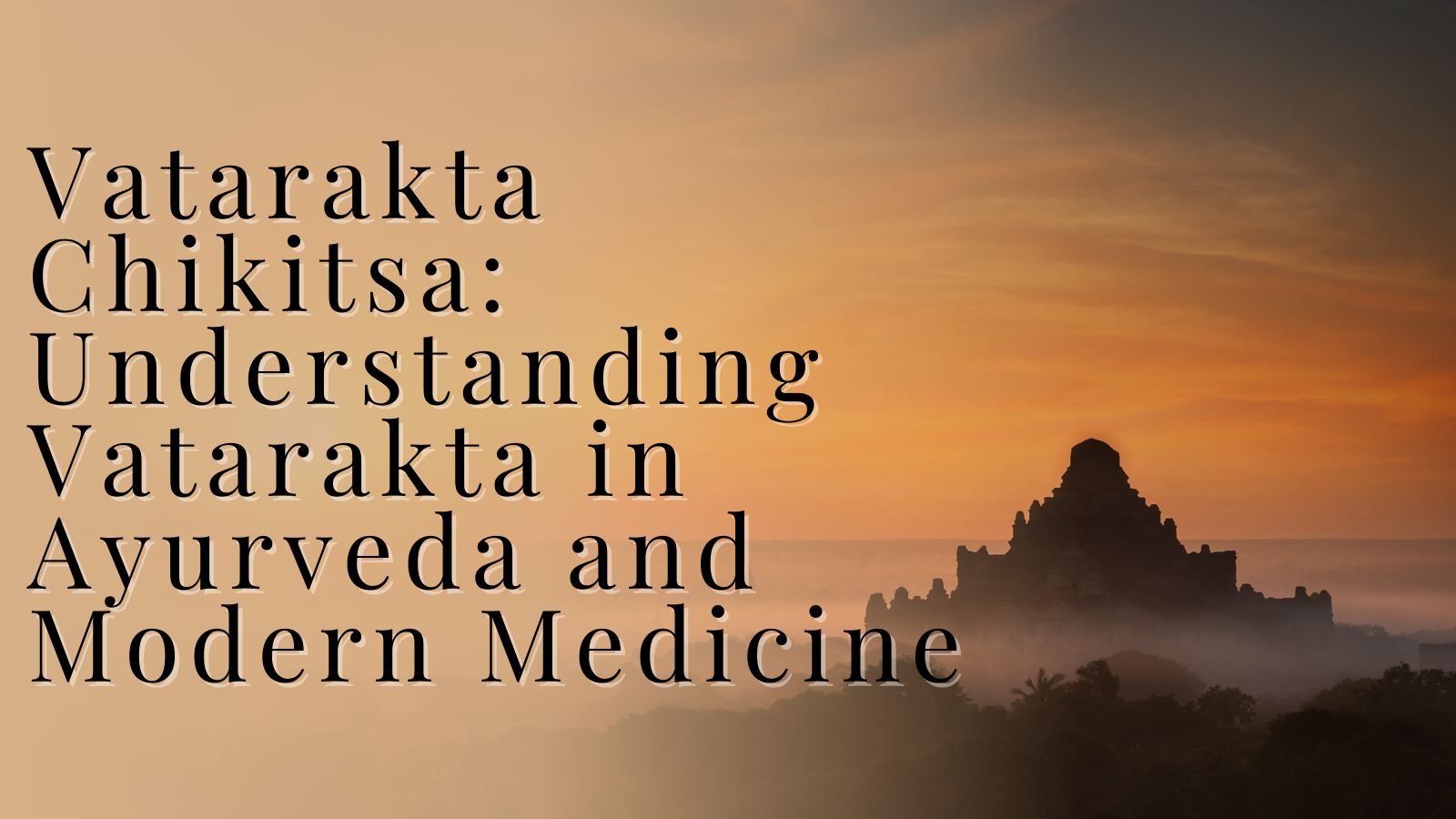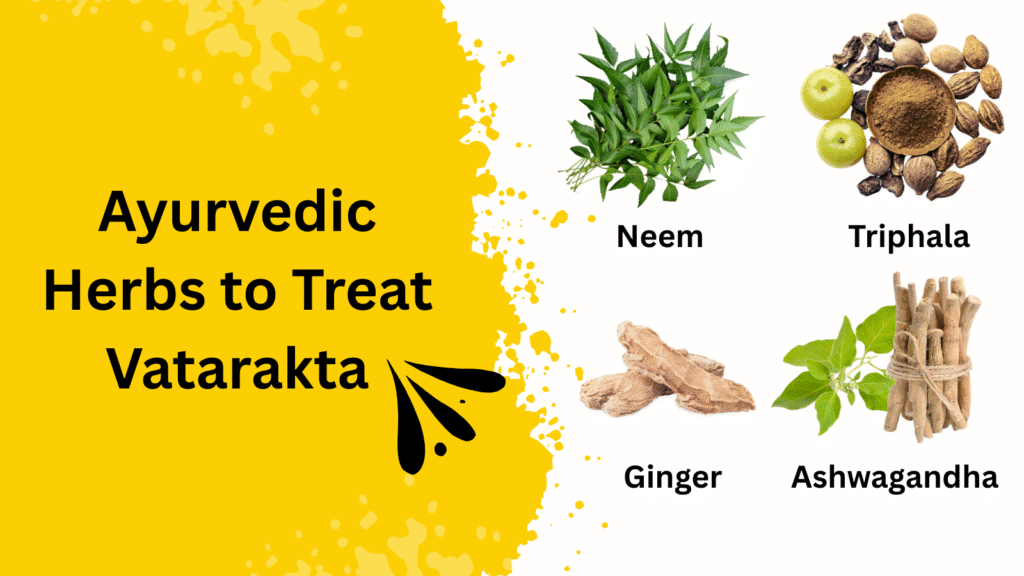
Vatarakta Chikitsa refers to the Ayurvedic treatment approach for managing Vatarakta, a condition commonly known as gout in modern medicine.
This condition, characterized by intense joint pain, inflammation, and swelling, can be effectively addressed using Ayurvedic principles.
By focusing on detoxification, balancing the doshas, and using natural remedies, Vatarakta Chikitsa offers a holistic way to manage and prevent gout flare-ups, promoting overall well-being.
What is Vatarakta and why is it important?
Ayurveda uses the word “vatarakta” to describe a condition that is like what modern medicine calls gout.
When uric acid crystals build up in the joints, they cause a lot of pain, redness, and swelling.
It usually hurts the big toe, but it can also hurt the knees, ankles, and elbows.
The symptoms come on quickly and usually happen at night, which is very uncomfortable.
Ayurveda says that Vatarakta is mostly linked to the Vata dosha, which controls how the body moves, and the Rakta (blood) system.
To gain a deeper understanding of how Vata dosha affects your overall well-being, check out our complete guide on Mastering Vata Dosha.
People think that when these two systems don’t work well together, waste products build up in the joints, which hurts and makes them swell.
Modern medicine, on the other hand, says that Vatarakta is a metabolic disorder that happens when there is too much uric acid in the blood.
This causes the uric acid to crystallize and settle in the joints.
Both Ayurveda and modern medicine agree that the condition hurts, makes it hard to move, and needs treatment.
This article will look at the Ayurvedic way of treating Vatarakta, the signs and symptoms of Vatarakta, the way Vatarakta samprapti (pathogenesis) works, and how Ayurvedic and modern treatments can work together to help with and ease the symptoms of this condition.
Vatarakta in Ayurveda: An Old Way to Treat Gout
Ayurveda says that Vatarakta is a disease that happens when the Vata dosha and the Rakta dhatu (blood) are not in balance.
The Vata dosha controls how fluids and energy move through the body, such as blood flow and getting rid of waste.
A bad diet, stress, not getting enough exercise, or things in the environment can make this dosha worse.
This messes up the Rakta (blood) system.
Ama, which are toxins, move around the body and settle in the joints because of this imbalance.
This leads to inflammation, pain, and stiffness, which are similar to gout symptoms.
Ayurveda views vatarakta not merely as a metabolic disorder, but as a systemic issue affecting the entire body.
It happens when the body can’t handle the natural ways it gets rid of toxins.
Toxins build up, especially in the joints, because the Rakta and Vata don’t work right.
When there is too much Ama, it stops Vata from moving freely. This makes the area hurt and swell, which are signs of Vatarakta.
Ayurveda, on one hand, tries to bring the body back into balance by finding and fixing the things that are wrong with it.
On the other hand, modern medicine uses drugs to control the symptoms of gout.
Ayurveda treats vatarakta with a combination of dietary changes, lifestyle changes, herbal remedies, and detoxification therapies like Panchakarma.
Vatarakta Samprapti: The development of Vatarakta in Ayurveda
Ayurvedic treatment is based on the idea that it is very important to understand Vatarakta samprapti, which is the way Vatarakta starts.
Samprapti is the name for the process by which a disease grows and spreads in the body over time.
Ayurveda says that Vatarakta starts when the Vata dosha gets worse, which makes it hard for blood to flow.
The Vata dosha moves around the body in strange ways, which causes Ama, or waste products, to build up in the joints.
When Ama builds up, it stops Rakta and other fluids from moving normally. This makes the joints swell and hurt as the toxins start to crystallize and settle in the tissues.
The condition gets worse over time, causing more swelling, inflammation, and the classic symptoms of Vatarakta, like joint stiffness and severe pain, especially at night.
Vatarakta samprapti also includes the formation of uric acid crystals in the joints.
Ayurvedic medicine says that Ama is the main cause, but modern medicine says that it is likely due to the formation of uric acid crystals.
The practice of Ayurveda also considers other factors that can lead to Vatarakta, such as poor digestion (Agni), an unhealthy diet, and lifestyle choices like overeating, excessive alcohol consumption, and insufficient physical activity.
These things make the digestive fire even weaker and make it harder for the body to get rid of waste, which leads to the buildup of Ama and the onset of Vatarakta.
Vatarakta Symptoms: Recognizing Gout Through Ayurvedic and Modern Lenses
Ayurveda and modern medicine both say that Vatarakta causes pain, redness, and swelling in the joints that are affected.
This is like gout. The pain in Vatarakta is usually sudden and very bad.
It usually affects the big toe, but it can also affect other joints. The area that is affected may get red, feel warm to the touch, and get bigger.
These symptoms are most obvious when they flare up, which can happen at night and make them even worse.
Ayurveda says that the Vatarakta symptoms happen when the Vata dosha messes up the body’s ability to get rid of waste and move Rakta around.
When Ama builds up, it causes crystals to form and an inflammatory response.
People think that the symptoms of Vatarakta are signs of bigger problems in the body, especially in the Vata and Rakta systems.
Modern medicine views swelling, redness, and intense pain as physical indicators of an issue, and it also recognizes these symptoms as indicative of uric acid crystal formation in the joints.
Blood tests that show high levels of uric acid confirm the diagnosis of Vatarakta, which is also known as gout.
Ayurveda and modern medicine both say that it’s very important to find and fix problems as soon as possible.
Vatarakta can damage the joints and cause other long-term problems if it is not treated.
Vatarakta in Modern Medicine: How Modern Medicine Sees Gout
Modern medicine calls vatarakta gout, which is a metabolic disorder that happens when there is too much uric acid in the blood.
Uric acid is a waste product of purine metabolism that usually dissolves in the blood and is removed from the body through urine.
But if the body makes too much uric acid or can’t get rid of it properly, it can build up in the joints and form crystals that hurt and make them swell.
One of the newest ways to find out if someone has Vatarakta is to do blood tests that look for uric acid levels in the body.
If these levels are high and there are signs of joint pain and swelling, a doctor will say you have gout (or Vatarakta).
To find uric acid crystals directly in the joint that hurts, doctors often do joint fluid tests at the same time.
In modern medicine, the main goals of treating Vatarakta are to lower the amount of uric acid in the blood and make the pain go away.
Some of the most common drugs used to treat pain and swelling are NSAIDs (like ibuprofen), corticosteroids, and colchicine.
It is also suggested that you change your lifestyle to help control the condition and stop it from getting worse.
For example, you could eat less purine-rich foods like red meat, shellfish, and alcohol, lose weight, and drink more water.
Ayurveda tries to fix the body’s imbalances naturally, but modern treatments can only help with the symptoms and not the disease itself.
Vatarakta Chikitsa: Ayurvedic Treatments for Gout Control
Ayurveda’s vatarakta chikitsa (treatment) is all about getting rid of Ama (toxins) from the body, cleaning it out, and getting the doshas back in balance.
Ayurvedic treatments for Vatarakta try to treat both the symptoms and the root causes of the condition, which can include poor digestion, a buildup of toxins, and emotional stress.
It also focuses on restoring balance to the doshas. For a detailed exploration of how the three doshas—Vata, Pitta, and Kapha—work together and impact your overall health, visit our comprehensive guide to Tridosha in Ayurveda.
Some ways for Vatarakta Chikitsa (treatment) are:
- Panchakarma Therapies: Panchakarma is an Ayurvedic detoxification process that uses therapeutic methods like medicated enemas, therapeutic vomiting, and bloodletting (Raktamokshana). These treatments help the body get rid of toxins, restore the natural flow of Rakta, and balance the doshas, especially Vata and Pitta.
- Herbal Remedies: Ayurvedic herbs are very important for treating Vatarakta. People often use herbs to treat Vatarakta. Some of these are Guggulu (a strong anti-inflammatory), Triphala (known for its detoxifying effects), Ashwagandha (a strong adaptogen), Turmeric (which has anti-inflammatory effects), and Ginger. These herbs help the body get rid of extra Ama, lower inflammation, and make blood flow better.
- Diet and Lifestyle: Ayurveda says that diet and lifestyle are very important for treating Vatarakta. You should stay away from foods that make Vata worse, such as processed foods, too much caffeine, and alcohol. People with Vatarakta should eat foods that reduce inflammation, such as turmeric, ginger, ghee, and warm, easy-to-digest meals. Yoga, meditation, and other ways to deal with stress are also good for your health and can help keep the Vata dosha in check.

Tips for controlling Vatarakta through diet and way of life
Ayurveda suggests a number of changes to your diet and way of life that can help with Vatarakta in addition to the treatments listed above:
- Dietary Guidelines: If you have Vatarakta, you should avoid foods that are high in purines, such as red meat, shellfish, and alcohol, because these foods raise uric acid levels. Ayurveda says that you should eat a lot of vegetables, fruits, and whole grains instead. Some foods that can help lower inflammation and get rid of toxins in the body are turmeric, ginger, and ghee.
- Exercise: Getting regular exercise helps your blood flow better, lowers inflammation, and stops toxins from building up. But you shouldn’t work out too much if it hurts your joints. People with Vatarakta should do light activities like swimming or yoga.
- Drinking enough water: Staying well-hydrated is important for getting rid of extra uric acid. Ayurveda says that drinking herbal teas and warm water can help your body get rid of toxins and digest food.
- Rest and Stress Management: To keep the Vata dosha in balance and improve your health in general, you need to get enough sleep and learn how to relax and deal with stress. Meditation and breathing exercises are two good ways to do this.
Integrating Ayurvedic and Modern Approaches to Treat Vatarakta
Combining Vatarakta chikitsa with modern medical treatments can help people with gout in a more complete way.
Ayurveda works to fix the underlying problems that cause the condition, like toxin buildup and Vata dosha imbalances.
Modern medicine can quickly relieve symptoms with drugs and changes to daily life.
Using both methods together can help people better manage Vatarakta, which can have long-term health benefits.

